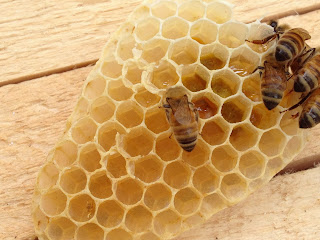Bee Hive Update: Drawing Comb
Yesterday Anita from Beverly Bees came by to check our hive. We suited up and got to work.
If you remember, we have a top bar hive. It's basically a big trapezoidal box with bars running across the top. The bees build honeycomb to hang from each bar. Our job is to check each bar to make sure they are building their comb nice and straight. We started from the back:
You can tell by the pure white color of the beeswax comb that this is brand new, and it's still quite soft. Kirk easily spotted the queen on this one, though she crawled around to the back by the time I snapped the picture. The bees are building this to fill the box, and the queen is laying eggs in each little hole.
Further down the line of bars, toward the hive entrance, there are completed combs that are much sturdier, which allows us to flip them upside down:
This comb is nice and straight, and you can see that it has taken on the shape of the box. The part that looks solid yellow is where the bees have capped off the brood cells so the eggs inside can grow into larvae and eventually hatch out a baby bee. Other holes have nectar and honey inside (which you can totally smell as you open the hive).
If you click on the photo above to enlarge it, you can see that to the right of the capped cells are some that look taller and domed. These will be male drones instead of female worker bees. Anita said that we actually have a lot of drones in this hive, but since we also have a good amount of workers it should be okay.
Not all the combs were so perfectly straight, though. Some had double lines overlapping and hanging from the same bar, and these had to be removed so we can adjust the remaining comb. It's soft when it's new, so you just tear off the messed up parts and smush the rest back into place. The bees fix the rest. Here's one of the little bits we had to remove:
There's a bit of nectar and honey inside, and these bees weren't too keen on giving it up. They'll find their way back into the hive later.
We'll need to check the bars once a week to make sure they're building straight comb and to refill their sugar water until they have enough food to feed themselves. If the comb goes diagonal across the bars, it'll all break instead of coming out cleanly if you let it go too long.
One of the combs we had to fix had big, white, squishy larvae in it. The worker bees got a little loud when we broke that off — understandable, since we were messing with their babies. Anita checked the larvae for varoa mites (none), and then we fed the larvae-laden comb to the chickens, who were psyched to get this sweet treat (the comb also had some nectar and honey inside). Everything inside a bee hive is edible, but I wasn't feeling adventurous enough to sample the bee larvae.
To encourage the bees to do a little better with their comb building ("drawing," as they say), we put an empty bar between two bars with straight comb, which give the bees some guidance to keep everything straight.
Then we closed it up and left them alone. Our sting count still stands at zero, and we'll open the hive up again next week to check their food and comb.







Comments
Post a Comment